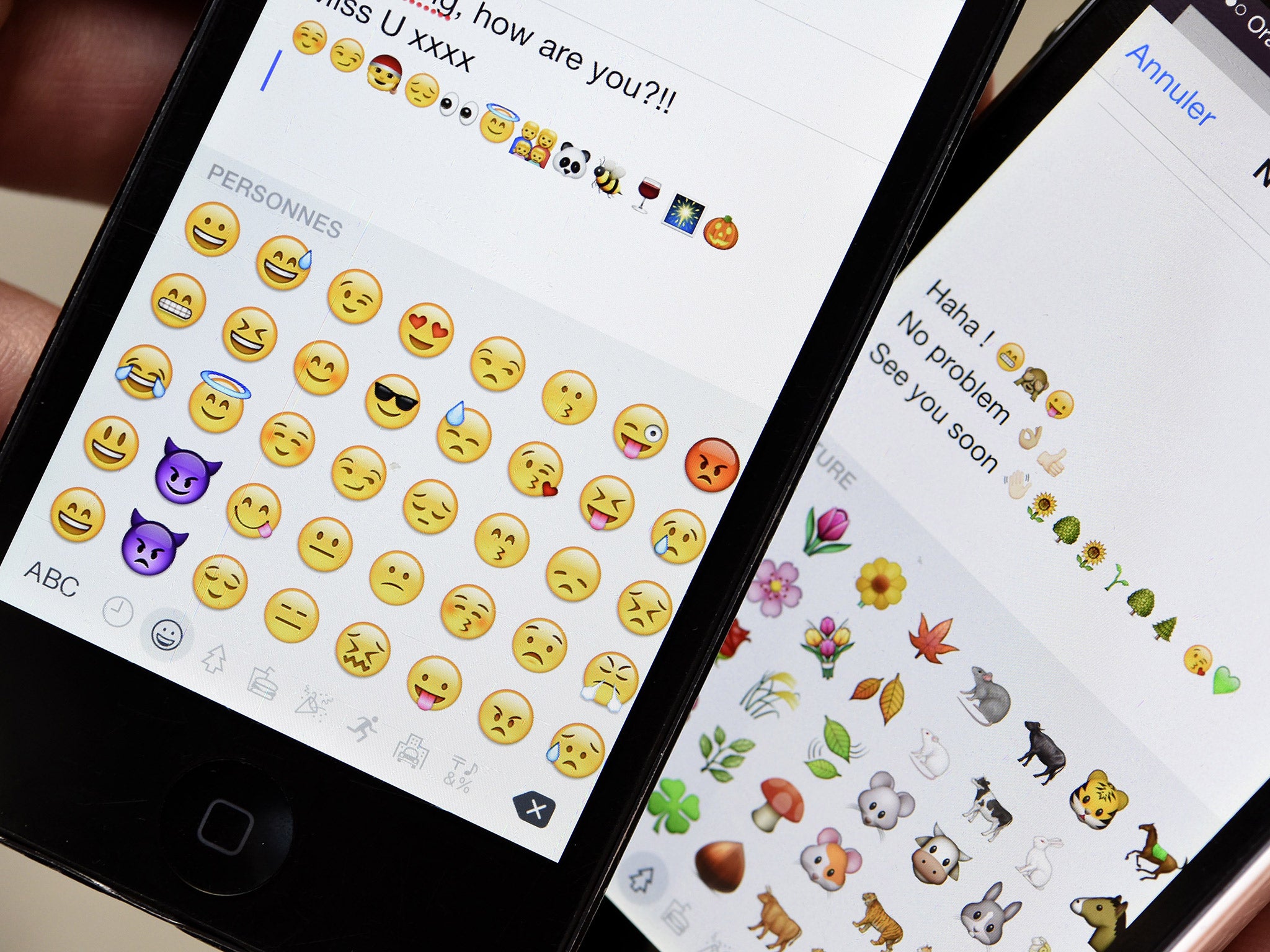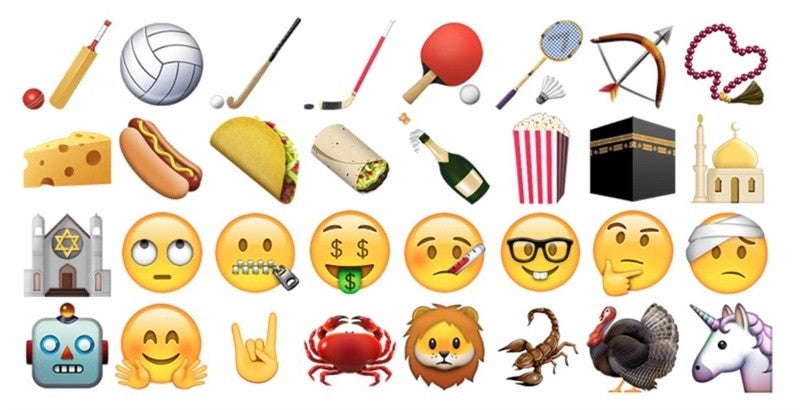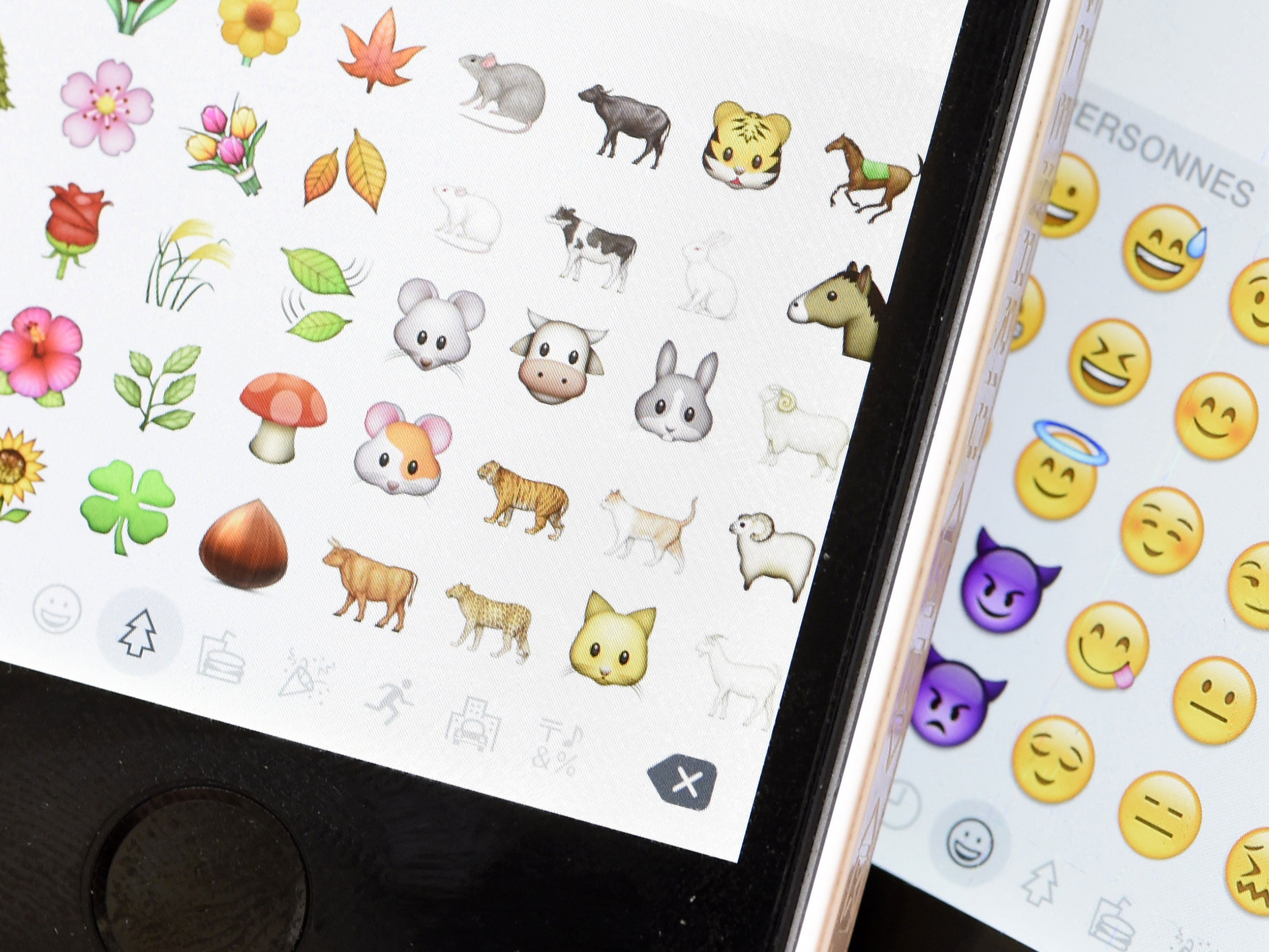Your support helps us to tell the story
From reproductive rights to climate change to Big Tech, The Independent is on the ground when the story is developing. Whether it's investigating the financials of Elon Musk's pro-Trump PAC or producing our latest documentary, 'The A Word', which shines a light on the American women fighting for reproductive rights, we know how important it is to parse out the facts from the messaging.
At such a critical moment in US history, we need reporters on the ground. Your donation allows us to keep sending journalists to speak to both sides of the story.
The Independent is trusted by Americans across the entire political spectrum. And unlike many other quality news outlets, we choose not to lock Americans out of our reporting and analysis with paywalls. We believe quality journalism should be available to everyone, paid for by those who can afford it.
Your support makes all the difference.By plenty of measures, 2015 has been a banner year for emojis. A Welsh professor declared them the fastest growing language in the UK. The New York Times used one in a headline, and a grid of them graced the cover of The New Yorker. Lawyers have cited emojis as evidence in dramatic courtroom trials. President Obama gave emojis a shout-out on the White House lawn, while Russian government officials threatened to ban same-sex emoji couples. To cap it all, last month the Oxford Dictionaries declared the tears-of-joy emoji the “word” of the year.
It now feels hard to imagine online communication without emojis, even if their explosion in popularity among English speakers only dates to October 2011, when Apple’s iOS 5 update bestowed the little icons upon millions of iPhones. (Gmail launched emoji support several years earlier, as did a number of third-party emoji apps, but neither of these developments paved the way for their mainstream adoption in the way that putting them on the iPhone’s virtual keyboard did.) With so much hype and excitement building in such a short timeframe, it’s fair to ask: Are we experiencing an emoji bubble? And what might life after emojis look like? We can find some possible answers to those questions in the birthplace of the emoji: Japan.
The very first emojis appeared on a handset sold by the company J-Phone (now Softbank) in 1997, but high prices kept it out of the hands of average citizens. The direct ancestors of the emoji we know and use today debuted in Japan in 1999. And now? “The emoji boom is over here in Japan,” says Shigetaka Kurita, the man widely credited with creating the adorable little runes. “They’re still around, they’re still pervasive, but they aren’t a fad any more,” he says in his Tokyo office. He ventures that when Obama mentioned emojis on the White House lawn, “I suspect most Japanese people’s response was, ‘wow, emoji are still popular over there?’ ”
Understanding the rise and fall of emojis in their homeland requires a little history. When Japanese telecom leader DoCoMo introduced proto-emojis in 1999, they were a core feature of the company’s i-mode service, the nation’s first to bring the internet to mobile phones. In comparison to modern standards, the crude dot-matrix designs are something like digital versions of the primitive single-celled organisms that once emerged from the primordial ooze. These monochromatic buttons share little more than a basic concept with the slickly designed, subtly drop-shaded smileys and figurines we know today. Kurita ran the team that designed and implemented them.
Kurita originally envisioned emojis as a workaround for mobile users to deploy rudimentary graphics despite the chokingly slow connection speeds of the era. But the little faces and hearts were quickly repurposed by young Japanese women, who found them irresistibly “kawaii”– cute – and began peppering their text messages with them. Their boyfriends followed suit, and before long emoji were booming. Surprisingly, DoCoMo declined to trademark the designs. “Headquarters discussed it with legal counsel,” says Kurita, “and the decision was that if you’re talking 12 pixels on a side, there isn’t much room for individual expression.” But this in turn allowed emojis to be adopted – some might say swiped – by DoCoMo’s competitors, allowing a single phone company’s feature to snowball into a massive nationwide phenomenon.

Emojis were such a phenomenon, in fact, that they nearly sank the Japanese launch of the iPhone in 2008. Mac desktops and laptops had long sold well in Japan, even during dark periods for the company in its home country. Nobody expected anything less from the sleek, hi-tech iPhone. There was just one problem: zero emoji capability. Unlike consumers in every other corner of the planet, Japanese customers stayed away from the iPhone in droves. It didn’t matter that it was a better piece of technology than anything else in Japanese stores. In a desperate bid to appease potential customers turned off by the lack of such a popular feature on the expensive phones, Masayoshi Son, president of Apple’s Japanese retail partner Softbank, convened an emergency press conference, declaring he had “convinced Apple that email without emoji isn’t email in Japan”.
It must have been quite the pitch. Apple quickly released a local update adding bare-bones emoji capability to Japanese iPhones. The company didn’t stop there. Behind the scenes, Apple worked in parallel with Google to “translate” emojis from the multiple conflicting formats used by the Japanese telecoms into Unicode, the universally accepted standard for text encoding on computers around the world. This would give emojis their green card for widespread use outside of Japan. But the efforts would also, ironically, pave the way for emojis’ downfall in their home country.
“Most Japanese people simply don’t find Apple’s emoji kawaii from a fundamental design standpoint,” Kurita said. “That style has moved away from what the emoji originally were.” His vision was more akin to the iconography of traffic signs or warning labels than mascots or characters. “The image in my mind was something close to text. Less ‘e’ [picture] and more ‘moji’ [letter]. So that no matter who looked at them, they could use them as icons, without taste coming into play. They were like pictograms or icons to me. Not decorations, but tools for communication, the same regardless of who used them.” The idea was to avoid stylistic flourishes so that emojis would be as universal as possible.

By the time Google and Apple began “localising” the emoji for use on Western computers and phones a decade later, display technology had leapfrogged the old screens upon which Kurita’s first emojis dwelled. The resulting demand for crisper graphics and more detailed imagery forced Western designers to “fill in the blanks” with their own interpretations, occasionally to the horror of Japanese emoji specialists.
Much of Japanese pop design, and kawaii design in particular, is open-ended and ambiguous by nature. What kind of animal is Pikachu? What’s that expression on Hello Kitty’s face? Leaving these things susceptible to interpretation allows characters to resonate with the broadest possible audience. Clarifying the emojis’ designs necessarily narrowed the number of potential interpretations of each one, raising questions of taste and style, which defeated the original concept underlying their popularity in Japan.
This shouldn’t be confused with cultural imperialism. The ethnically diverse teams that localised emojis did so with great care and respect. But Japan’s emojis had been crafted based on a unique pop-cultural sensibility derived in large part from cartoons and comic books, iconography not necessarily shared by people from other countries. (We have our own versions of these symbols, such as a light bulb appearing over a character’s head to indicate inspiration.) When Western design departments started tinkering with them, adding their own taste and flair, much of the Japaneseness of the designs was lost.

And so Japanese netizens moved on. The big thing in Japan now is Line, a wildly popular free messaging app that has some 58 million domestic users, though almost no profile abroad. Its key feature is users’ ability to send “stamps,” essentially mascots and cartoon characters, back and forth. Emojis differ slightly from platform to platform; Android’s don’t precisely resemble those used on Apple or Twitter or Skype, and vice versa. But since Line users are all aboard the same service, the stamps are always the same. And many are set to automatically pop up in a window based on what you type, just like predictive text or spelling suggestions. The emojis are still there, too. But they’re relegated to a sideshow role rather than being the main event, all but upstaged by the far more flamboyant stamps.
Line stamps also have a big leg-up on emojis from another standpoint: commercialisation. The company’s main source of revenue is hawking an ever-changing array of new stamp sets to customers, many of which are designed in concert with big corporations merchandising their product lines. Line makes a great deal of money from paid corporate and celebrity tie-ins, which can run into the hundreds of thousands of dollars depending on the length of the campaign. On the other hand, even a company as deep-pocketed as Disney wouldn’t be able to pay Unicode to immortalize Mickey, Goofy, and the rest of the crew as emojis. The emoji system simply isn’t designed for monetisation. There’s no such barrier with Line.

The emojis have also taken another hit in Japan from an unlikely culprit: emoticons, those little pictorial representations of facial expressions constructed from punctuation marks. The West has emoticons and text art, too, of course. Most English-speaking net users are familiar with the ubiquitous smiley :-) and frowny :-( marks and a handful of others. But Japanese emoticons – known as kaomoji, or face-text – come in a dizzying array of variations. They are complicated mixtures of punctuation, Japanese kana, foreign letters, and even scientific symbols, resembling something Dr Frankenstein might have built had he majored in linguistics rather than played God. Perhaps the most common is キヌ––––(°∀°)––––!! Pronounced kita, it’s the illustration of an excited “all right!” or “here we go!” that’s deployed endlessly on Japanese Twitter and chat rooms. The kaomoji express emotions in the way emojis do, but they’re composed of standard fonts rather than being illustrated by anyone in particular. This lets the constructions retain more ambiguity design-wise, which is a fancy-pants way of saying they’re more kawaii.
So bearing all of the above in mind: if emojis are in their twilight in their homeland, what are the implications for their popularity abroad? Are we heading for an “emojipocalpyse”?
Several facts cloud the prognosis. The first is that emojis are far more popular abroad than they ever were in their birthplace. Even at Japan’s moment of what might be called peak emoji around 2008, nobody thought to enshrine them in the dictionary or wage a bidding war over “Emoji: The Movie”. The second is simple demographics. The prospect of monetising emojis in the way Line has its stamps would be a mouth-watering prospect for a tech company, but it’s hard to imagine any single app or even social network coming to dominate the massive universe of English-language texting in the way Line dominates Japan’s. And finally, in Japan, the emoji fad was predominantly driven by young women. There are no such age or gender restrictions abroad. Everyone from your mother to your drug dealer uses them.
“I created emoji for use in Japan,” Kurita says, “but no matter where you are, whenever there’s text on a screen, there’s a need for an emotional component.” If the arc of emojis’ popularity in Japan is any indication, what’s more likely to happen is a slow fade. A world where emojis are yet another, wholly unremarkable way of expressing feelings online and on screen, with no more thought put into using them than choosing a font or deploying italics. Which is, of course, exactly what their creator envisioned for them in the first place.
© Slate.com
Signs of the times: Emojis past and present
If a picture is worth a thousand words, then many of us are routinely sending PhD-length essays to our friends over Twitter. What began as the odd smiley-face sign-off and thumbs-up on MSN has evolved into a whole new language that allows us to describe our lunch in detail or express our verdict on the election results using just little pictures, and nowadays comes complete with inclusive shorthand for same-sex relationships and a variety of handy ethnic profiles.
It was the launch of emoji on iPhone and Android that embedded it in our daily communication. Since then, the little pictographs have become such an integral part of online interactions that most of us struggle to remember a time without them, despite their only being popular since 2011.
Our reliance on emojis to communicate inevitably led to emoji politics. It was a whole year before tiny pictures of same-sex couples were introduced alongside their heterosexual counterparts in 2012, and it wasn’t until 2015 that Apple users finally gained the option to choose the skin colours on their emojis’ faces – and their thumbs-up signs – with the launch of iPhone iOS 8.3. This development was met with an odd mix of joy and outrage: while it was a long overdue victory for tolerance and diversity, some were concerned that the new emojis would be a useful tool for bigots, while others complained that people of colour would now be faced with the strange obligation to use a “matching” emoji every time they felt moved to give a thumbs-up.
Diversity wasn’t the only issue – there was mild outrage online over the lack of symbols for cheese and tacos (both of which are now newly available). A change.org petition for a tiny taco to be added to the app collected more than 32,000 signatures, and Tesco was at the forefront of the emoji “cheese-olution” on Twitter. Meanwhile, Ginger Parrot, a “website for redheads and ginger lovers”, is currently running a petition to add red hair to the options for emojis, which currently only include blonde and brunette.
The Oxford Dictionary word of the year for 2015 was the “tears of joy” emoji, a decision that provoked howls of derision from the non-technologically inclined. In fact, this addition was very telling: the word of the year in 2010 was “app” and “tweet” the year before that. In 2008 the word was “bailout” – in reference to bailing out a bank. These are all words that once upon a time we had no need for, but nowadays we can’t live without.
So what’s next for emojis? Fans of Star Wars can currently use the hashtags #stormtrooper, #C3PO and #BB8 on Twitter and have a Star Wars emoticon automatically show up next to the word. Scandinavians and scandi-lovers can now download the new “Nordic Emoji”, which includes long-haired rock gods and lots of very cold-looking people. In 2016, Apple users can hope for 38 new emojis to play with, including bacon strips, champagne, a pregnant woman, a groom to go along with the bride – and the introduction of Mrs Claus.
Elsa Vulliamy

Join our commenting forum
Join thought-provoking conversations, follow other Independent readers and see their replies
Comments